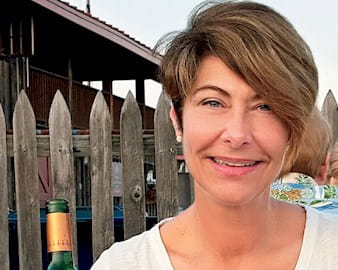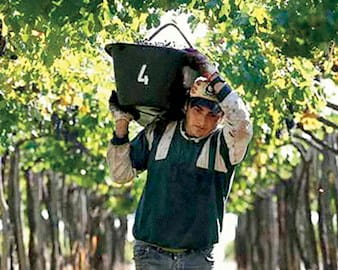
A globe-trotting Booth couple talks about their path into winemaking and advises how to get the most out of your next bottle.
- By
- October 10, 2018
- Career Change

It’s the stuff of daydreams, really. One minute you’re bemoaning the high price of wine for your dinner parties and the next you’re the vineyard owner, with a thriving boutique winery that produces several types of Argentinian reds.
That fairy tale is real life for husband-and-wife business partners Jan Soderberg and Bill Smith, both ’90 (XP-59), who run Vistaflores Estate in Mendoza, Argentina.

Soderberg, who focuses on marketing for the winery, received an undergraduate degree in journalism and worked in development for National Public Radio before enrolling in law school in her hometown of Chicago. She was 26 years old when she took the bar exam; the same week, her father died. Unexpectedly, she ended up taking over his property-casualty insurance company.
“I went to Booth to get my MBA because I ended up in business and had no background in it,” said Soderberg, who met Smith in the program.
That business eventually got sold and Soderberg found herself at a large consulting firm in New York, which got bought out in 1997. Next came a sojourn in Paris and some traveling, which ultimately took her and Bill to South America. They fell in love with Punta del Este, Uruguay, known as the “Saint-Tropez of Uruguay,” where the Silver River meets the Atlantic Ocean, the beaches are plentiful, and the weather is temperate.
“We thought, ‘This is fabulous,’ and bought land there and built a house,” Soderberg said.
She soon started a club for English speakers and met expats from all over the world. Soderberg enjoyed entertaining and started serving Argentinian wine at her parties.
Around 2006 her husband suggested the two tour some wineries.
“We decided to buy vineyards and get into the wine business, which just may have been the dumbest thing we’ve ever done,” she said with a hint of a laugh.
But the two, already fans of good wine, decided it would be an exciting challenge to work in an industry that had a tangible product.
“I like to have a product, to touch and to feel it,” Soderberg said. “We’re really farmers. We’re on the land. Sometimes I’m pulling weeds. Your connection with your product is very meaningful.”
“We're really farmers. We're on the land. Sometimes I'm pulling weeds. Your connection with your product is very meaningful.”
— Jan Soderberg
So they bought three vineyards in Argentina, to diversify their risk against bad weather, earthquakes, and other calamities beyond their control. Each vineyard has a home on the property, for the family who works the land to live. They’ve hired agronomists and a well-respected winemaker to shepherd their grapes into high-end malbecs, a cabernet franc, and two red blends.
The winery produces 4,000 to 5,000 cases per year, with bottles retailing from $18.50 to $60. The US market, with its heavily controlled distribution networks, is challenging, she said, so Vistaflores wines are found in a small number of American cities. But the winery has a larger presence in Canada, Brazil, Australia, Hong Kong, and the Caribbean.
“You learn as you go,” Soderberg said. “Hopefully, you learn fast.”
It’s an industry that is multifaceted and ever-challenging, Smith said.

“To me, the greatest challenge is anticipating demand,” he said. “As an Argentine winery, we have to be very aware of changes in consumer attitudes. How do consumers view Argentina? Argentine wines? Red blends? The 2018 harvest, depending on quality, will be available between this November and November 2021. What will the market look like then? If we are not sure, we will tend to make entry-level wines, which can be sold quickly despite the lower margins.”
Soderberg, who has spent much of her career in marketing, particularly enjoys the experience of creating blended wines from barely aged creations.
“I was accustomed to drinking wine, but as a finished product,” she said. “You learn and you keep doing it. . . . You’re tasting constantly, and after a while, you understand how the wine elaborates."
To create a blend, the winemakers must envision how a wine will taste several years in the future, she said.
“We sit at the table and we all taste, and everybody votes,” she said.
With so many wineries and a growing appreciation in America for Argentinian wines, Soderberg said what sets her winery apart is the commitment to quality.
“As a boutique winemaker, if I put out a wine that is substandard, I’d rather not make the wine because the quality is not there,” she said. “Quality starts in the vineyard. You have to do everything you can to get the best grapes you can get.”
Soderberg readily admits that buying vineyards in Argentina was a fairly crazy decision. But it’s not one she ever regrets.
“If life’s a journey, this has been a very interesting one,” she said. “At the end of the day, when I go home from work, I get to open one of my bottles of wine and enjoy it and that is very satisfying.”
Wine Pairing 101
The old rules of red wine with meat and white with fish and veggies? Forget those. “Serve what you like,” Soderberg said. “And it’ll go just fine.” Living part of the year on the eastern shore of Maryland, Soderberg said one of her favorite pairings is Maryland blue crabs, covered in Old Bay Seasoning, served with one of her red blends. “The spices of Old Bay are very strong, and my wine can stand up to that,” she said. “They’re complementary.”
Soil Matters
The mystical blend of soil, climate, and other factors that affect the flavor of a finished wine are, in short, a big deal. Terroir, as the concept is known, means that the same grape grown in Argentina and the South of France will produce vastly different bottles of wine. The first year in Argentina, Soderberg tried to make a merlot, to replicate the flavor of Pomerol, one of her favorite blends from Bordeaux. “I tasted our merlot and it was not Pomerol, not even close,” she said. “The terroir makes all the difference. You’re not going to get merlot tasting like Pomerol in Argentina.”
Wine Tutorial
What’s the best way to learn about a particular type of wine? Decide on a region to focus on, head to the wine shop, and buy a couple of bottles, she said. Then, ask your friends to bring over wines from the same country or wine-growing area. “You open them and you sit them side by side and you start tasting,” she said. “What flavors do your guests get? What foods go with it? This is the fun part.”